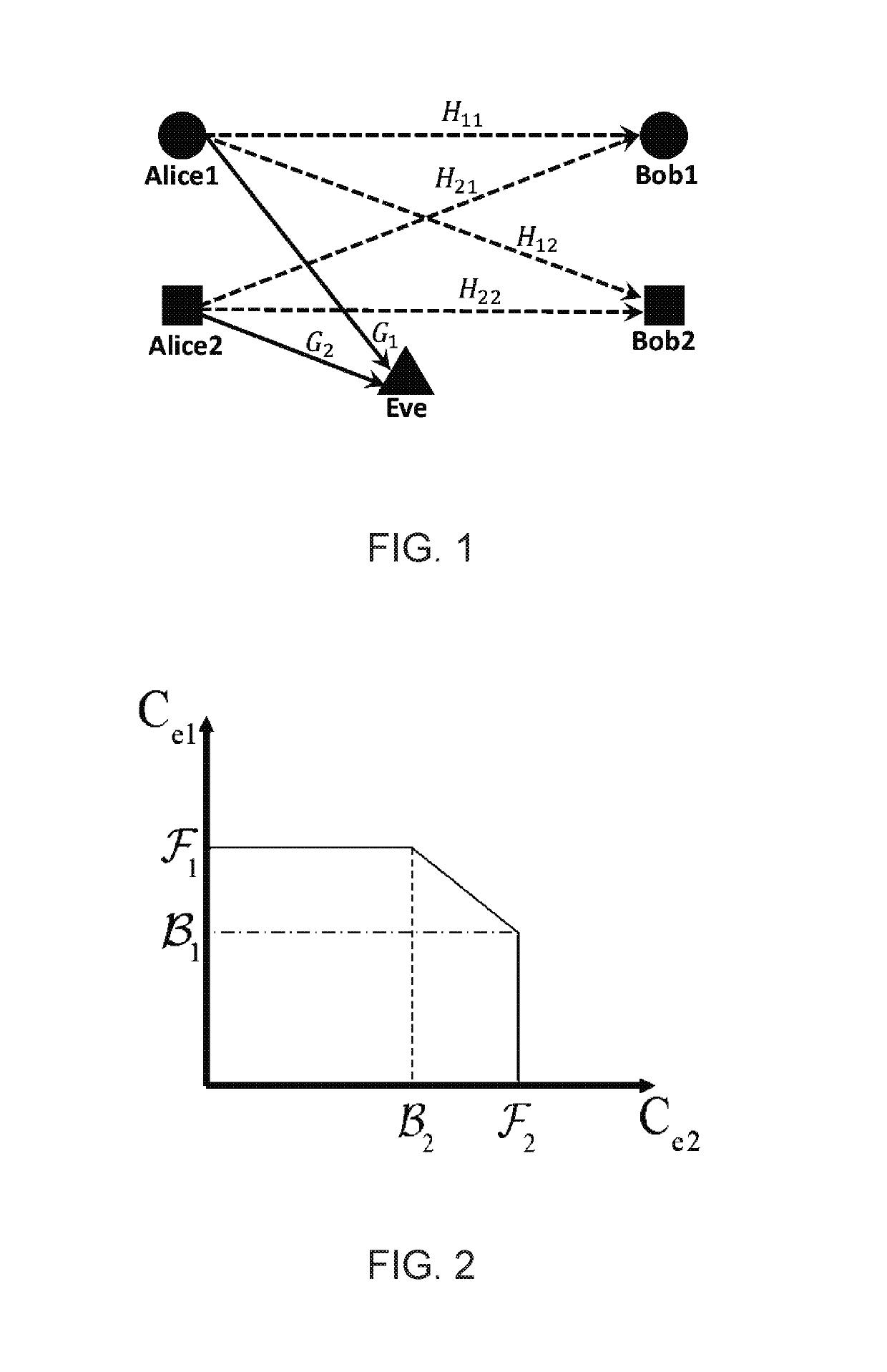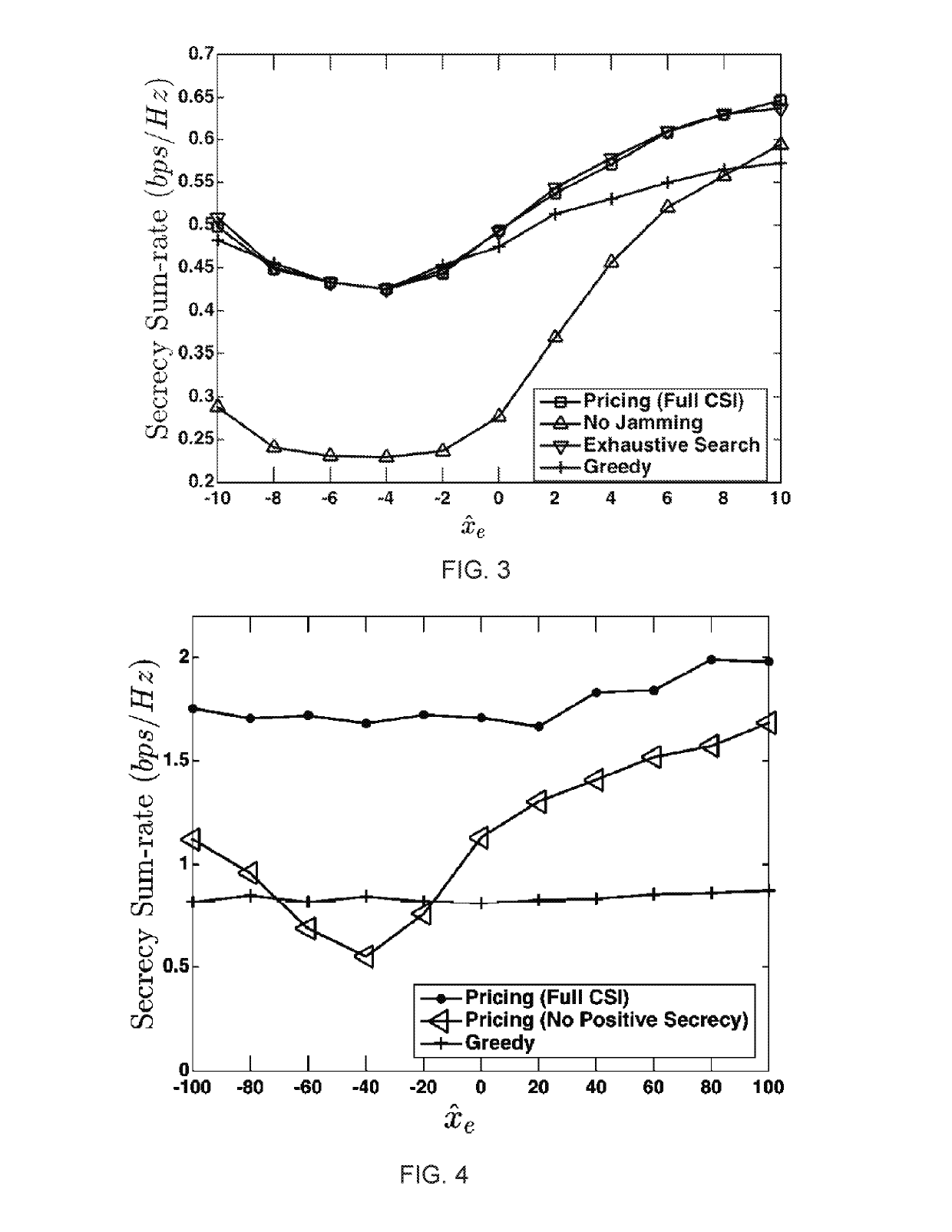Systems and methods for securing wireless communications
a wireless communication and wireless technology, applied in the field of wireless communication security systems and methods, can solve the problems of reducing the secrecy rate of other wireless links in the system, imposing penalties on each transmitting mobile device, etc., and achieve the effect of maximizing the secrecy sum-rate of the system and a larger area
- Summary
- Abstract
- Description
- Claims
- Application Information
AI Technical Summary
Benefits of technology
Problems solved by technology
Method used
Image
Examples
example 1
[0068]The following is a non-limiting example of a price-based jamming control that can guarantee a local optimum for secrecy sum-rate.
[0069]System Model
[0070]A communication scenario is shown in FIG. 1, where two transmitters, Alice1 and Alice2 communicate with two respective receivers, Bob1 and Bob2. Each transmitter (TX) q, q=1, 2, has NTq transmit antennas. A passive eavesdropper (i.e., Eve) with one antenna exists in the range of communication. The received signal by the qth receiver, yq, can be written as:
yq={tilde over (H)}qquq+{tilde over (H)}rqur+nq, r,q∈{1,2}, r≠q (1a)
where HqT denotes the 1×NTq channel matrix between the qth transmitter and the rth receiver, uq is the transmitted signal from the qth transmitter, and nq is the complex Additive White Gaussian Noise (AWGN) with the power N0. We assume that HqT is a zero mean complex Gaussian matrix. Let Gq denote the 1×NTq complex channel matrix between the qth transmitter and Eve. Eve's received signal is
z={tilde over (G)}...
example 2
[0151]The following is a non-limiting example of a scenario where a transmitter sends two independent confidential data streams, intended to two legitimate users, in the presence of an eavesdropper of an unknown location.
[0152]System Model
[0153]As shown in FIG. 8, we consider a two-user broadcast channel in which Alice transmits two independent confidential data streams to Bob and Charlie in the presence of Eve. Let the number of antennas at Alice and Eve be NA and NE, respectively. The intended receivers, Bob and Charlie, have FD radios, each with a single antenna [16b]. Let xA ∈NA×1 be Alice's transmit signal, which includes two information messages plus TxFJ. Let xB and xC denote the transmit RxFJ signals from Bob and Charlie, respectively. The signals received by Bob, Charlie, and Eve are, respectively, given by:
yB=hABxA+hBBxB+hCBxC+nB (1b)
yC=hACxA+hBCxB+hCCxC+nC (2b)
yE=HAExA+hBExB+hCExC+nE (3b)
where hAB∈1×NA, hAC∈1×NA, hBE∈NE×1, and hCE∈NE×1 are the channel vectors between A...
example 3
[0210]The following is a non-limiting example of friendly jamming for PHY-layer security in small-scale multi-link wireless networks in the presence of eavesdroppers.
[0211]Distributed MIMO for FJ Nullification
[0212]If the FJ signals are to be generated by the same MIMO node (e.g., Alice), then the phases of these signals can be easily controlled to provide the desired nullification. A set of FJ signals can add destructively and nullify each other at an intended receiver if these signals, each of which traverses a different channel, are received out-of-phase and sum up to zero. To achieve this, techniques such as zero-forcing beamforming are employed to determine the phase and amplitude of each FJ signal at the transmit antennas. However, in general, FJ signals may be produced by different devices that do not share a reference clock and so are not synchronous. Hence, the signals transmitted from distributed FJ nodes may experience unknown random delays. In this section, we explain ho...
PUM
 Login to View More
Login to View More Abstract
Description
Claims
Application Information
 Login to View More
Login to View More - R&D
- Intellectual Property
- Life Sciences
- Materials
- Tech Scout
- Unparalleled Data Quality
- Higher Quality Content
- 60% Fewer Hallucinations
Browse by: Latest US Patents, China's latest patents, Technical Efficacy Thesaurus, Application Domain, Technology Topic, Popular Technical Reports.
© 2025 PatSnap. All rights reserved.Legal|Privacy policy|Modern Slavery Act Transparency Statement|Sitemap|About US| Contact US: help@patsnap.com



